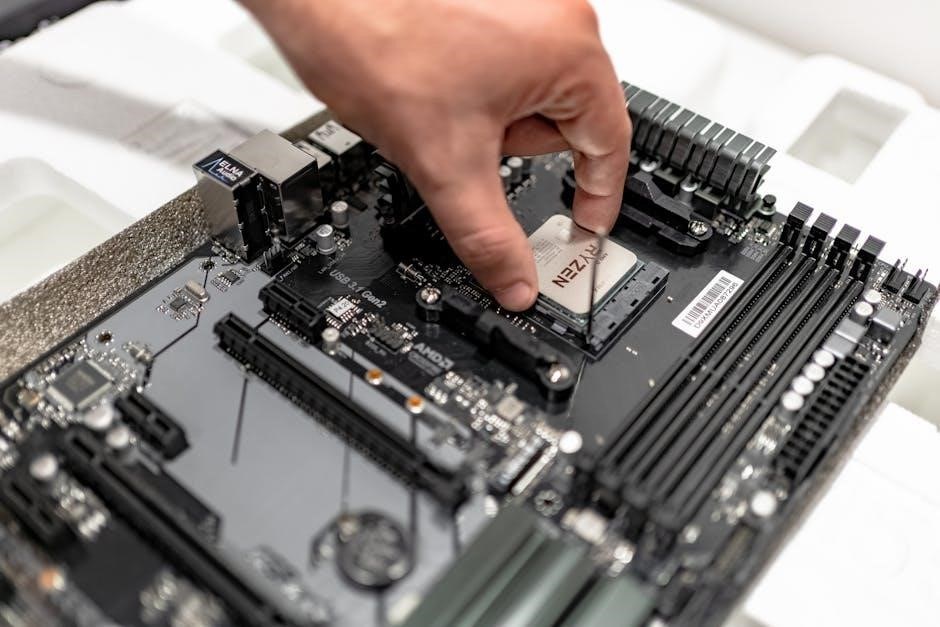The XNX Universal Transmitter is a flexible, reliable gas detection solution supporting multiple sensing technologies, including electrochemical, infrared, and catalytic bead. Designed for industrial applications, it ensures accurate monitoring of flammable, toxic, and oxygen gases, while complying with global safety standards. Its modular design allows for easy integration with various communication protocols like HART, Foundation Fieldbus, and Modbus, making it a versatile choice for hazardous environments. The transmitter also features hot-swappable sensors and a user-friendly interface for seamless operation and maintenance.
1.1 Overview of the XNX Universal Transmitter
The XNX Universal Transmitter is a versatile gas detection system designed for industrial applications, supporting electrochemical, infrared, and catalytic bead sensors. It offers reliable monitoring of flammable, toxic, and oxygen gases, ensuring safety in hazardous environments. The transmitter features hot-swap sensor capability for uninterrupted operation during maintenance; With support for HART, Foundation Fieldbus, and Modbus communication protocols, it integrates seamlessly into existing control systems. Its modular design and remote mounting options enhance flexibility, while compliance with ATEX, CSA, and FM standards ensures reliable performance in global markets.
1.2 Key Features and Benefits
The XNX Universal Transmitter offers advanced features such as universal compatibility with multiple gas sensors, including electrochemical, infrared, and catalytic bead technologies. It provides dual-channel detection for enhanced monitoring and supports HART, Foundation Fieldbus, and Modbus protocols for seamless communication. The transmitter includes non-intrusive calibration and hot-swappable sensors for minimal downtime. Its robust design ensures operation in harsh environments, while compliance with international safety standards like ATEX, CSA, and FM guarantees reliability. The XNX also features user-friendly configuration and diagnostics for efficient setup and troubleshooting, making it a reliable choice for industrial gas detection systems.

Installation Requirements
The XNX Transmitter requires a 16 to 32 VDC power supply, proper grounding for intrinsic safety, and adherence to mounting and wiring guidelines to ensure safe operation.
2.1 Mounting Options for the XNX Transmitter
The XNX Universal Transmitter offers versatile mounting options to suit various installation needs. It can be securely attached to a flat wall surface using integral mounting tabs or mounted on a pipe with a diameter of 50 to 150mm using an optional Pipe Mount kit. Additionally, the transmitter can be fitted to a Unistrut for flexible installation. These mounting solutions ensure stability and ease of access, allowing the transmitter to be positioned optimally for reliable gas detection in industrial environments.
2.2 Power Supply Requirements (Voltage and Power Sources)
The XNX Universal Transmitter requires a DC power supply, with specific voltage ranges depending on the model. For EC and mV versions, the voltage range is 16 to 32 VDC, while for Single Transmitter Searchpoint Optima Plus and Searchline Excel, it is 18 to 32 VDC. The power source must be compatible with intrinsic safety requirements, and an approved barrier should be used in hazardous areas. Ensure the power supply is properly grounded and meets local electrical standards for safe and reliable operation.
2.3 Safety Considerations and Precautions
Ensure the XNX Transmitter is installed in accordance with recognized safety standards for hazardous locations. Proper grounding and bonding are essential to prevent ignition hazards. Avoid exposing sensors to extreme temperatures, organic solvents, or flammable liquids. When handling EC sensor cells, wear protective equipment, as they contain corrosive solutions. Do not tamper with or disassemble sensors. Ensure all cable shields are properly terminated at cable glands to prevent EMI interference. Adhere to local regulations for environmentally safe disposal of sensors at end of life. Always follow manufacturer guidelines to ensure safe operation and compliance with international standards.


Mounting and Wiring
The XNX Universal Transmitter can be mounted on a flat wall, Unistrut, or pipe using integral tabs or an optional pipe mount kit. Ensure proper wiring with shielded cables for EMI protection, terminating shields at cable glands. Secure all connections to avoid signal interference and ensure compliance with safety standards.
3.1 Mounting the Transmitter on a Wall or Pipe
The XNX Universal Transmitter can be securely mounted on a flat wall or pipe using its integral mounting tabs or an optional Pipe Mount Kit. For wall mounting, ensure the surface is flat and sturdy to support the transmitter’s weight. When mounting on a pipe, the optional kit accommodates pipes with diameters of 4 to 6 inches (100 to 150mm). Use a U-bolt and bracket to ensure a stable and secure installation. Proper alignment is crucial for accurate gas detection and transmitter performance. Always follow the manufacturer’s guidelines for mounting hardware and torque specifications to avoid damage or misalignment.
3.2 Wiring the Transmitter (General Considerations and Connections)

When wiring the XNX Universal Transmitter, ensure all connections are secure and comply with local electrical codes. Use shielded cables to minimize EMI interference, terminating shields at cable glands. The transmitter operates on 16-32 VDC, depending on the model and sensor type. Connect the power supply to the designated terminals, ensuring proper polarity. For 4-20mA output, use a common connection to avoid signal interference. Ground the transmitter and sensor for intrinsic safety and EMI protection. Follow the manual for specific wiring diagrams and distance limitations to ensure reliable performance and compliance with safety standards.
3.3 Distance Considerations for Installation
The XNX Universal Transmitter’s installation must consider wiring distances to ensure signal integrity and power supply stability. Maximum cable lengths vary depending on the output type and communication protocol. For 4-20mA signals, distances up to 3,000 feet (914 meters) are possible with proper shielding. Foundation Fieldbus and HART connections may have shorter limits due to communication bandwidth constraints. Always follow the manufacturer’s guidelines for specific configurations to avoid signal degradation and ensure compliance with safety standards. Proper planning minimizes interference and maintains reliable performance across the installation.

Configuration and Setup
The XNX Universal Transmitter requires initial configuration to recognize sensors and option boards. Configuration options include setting alarms, range parameters, and communication protocols via menus or software tools.
4.1 Initial Configuration of the XNX Transmitter
The initial configuration of the XNX Universal Transmitter is essential for proper operation. Upon startup, the transmitter performs a self-test and enters monitoring mode. If a new option board is added or removed, the XNX must be configured to recognize it, which may trigger a fault code (e.g., Fault 152). Configuration is done via the transmitter’s menu system or external software tools. Parameters such as sensor type, range, and alarms must be set according to the application requirements. Refer to the manual for detailed procedures and safety guidelines to ensure correct setup and avoid potential hazards.
4.2 Configuring Option Boards (HART, Foundation Fieldbus, etc.)
Configuring option boards like HART or Foundation Fieldbus requires careful setup to ensure proper communication. For HART, install the DTM software and follow the Device Type Manager (DTM) manual to configure settings. Foundation Fieldbus wiring must adhere to specifications, with proper termination and cable shielding. Ensure all connections are secure and grounded to prevent interference. Refer to the XNX Foundation Fieldbus manual for detailed wiring diagrams and configuration steps. Always power down the transmitter before installing or removing option boards to avoid damage or malfunctions.
4.3 Setting Up Alarms and Range Parameters
Configure alarms and range parameters to ensure accurate gas detection and response. Set the alarm levels (low, high, and fault) based on your application requirements. Use the menu-driven interface to assign latch or non-latch modes for alarms. Define the measured gas concentration levels for each alarm trigger. Ensure the range parameters align with the sensor type and gas being monitored. Test the alarm functionality after setup to confirm proper operation. Refer to the technical manual for detailed instructions and safety protocols to avoid misconfiguration.

Calibration and Maintenance
Regular calibration ensures accurate gas detection. Follow procedures for sensor calibration, adjustment, and verification. Perform routine maintenance, including cleaning and replacing sensors as needed, to maintain reliability and compliance with safety standards.
5.1 Calibration Procedures for the XNX Transmitter
The XNX Transmitter requires regular calibration to ensure accurate gas detection. Begin by powering on the transmitter and allowing it to complete the startup routine. Use the appropriate zero and span gases to calibrate the sensor, following the manufacturer’s guidelines. Perform a bump test before calibration to verify sensor responsiveness. Adjust the zero and span settings as needed to achieve the correct readings. After calibration, verify the sensor’s performance and ensure all diagnostic features, such as alarm latching, are properly configured. Document the calibration results for compliance and maintenance records.
5.2 Replacing Sensors and Maintenance Tasks
To replace sensors on the XNX Transmitter, power off the device and disconnect the power source. For MPD sensor cartridges, remove the old cartridge and install the new one, ensuring proper alignment and secure locking. For EC sensors, handle them carefully to avoid damage from corrosive solutions. After replacement, restart the transmitter and perform a zero calibration. Regular maintenance includes cleaning the transmitter housing, inspecting cable connections, and verifying tightness. Always follow safety guidelines and dispose of old sensors responsibly. Periodic bump tests are recommended to ensure proper sensor function and system reliability.
5.3 Troubleshooting Common Issues
Common issues with the XNX Transmitter include sensor failure, configuration errors, and electrical connectivity problems. For sensor failures, check for exposure to harsh chemicals or extreme temperatures. Fault 152 indicates a configuration issue after sensor replacement, requiring transmitter reconfiguration. Electrical issues may arise from incorrect voltage or poor connections. Verify power supply and wiring integrity. If problems persist, reset the transmitter or consult the technical manual. Always ensure proper grounding and follow safety protocols when troubleshooting to avoid further complications and ensure reliable operation. Regular maintenance can prevent many of these issues.

Safety and Compliance
The XNX Transmitter complies with international standards like ATEX, CSA, and FM, ensuring safe operation in hazardous environments. Proper disposal and adherence to local regulations are essential.
6.1 Warnings and Cautions for Safe Operation
Warning: Do not tamper with or disassemble sensor cells, as they may contain corrosive solutions. Avoid exposing sensors to extreme temperatures or organic solvents. Ensure proper grounding for intrinsic safety and to prevent radio frequency interference. Shielded cables must have proper termination at cable glands. Do not terminate cable shields at the Earth ground lug inside the XNX enclosure. In hazardous locations, avoid actions that could cause sparks or ignition. Properly dispose of sensors at end of life, following environmental regulations. Failure to comply may result in sensor damage or inaccurate readings.
6.2 Compliance with International Standards (ATEX, CSA, FM, etc.)
The XNX Universal Transmitter is designed to meet global safety standards, including ATEX, CSA, FM, and ISO 9001 certifications. It ensures safe operation in hazardous environments, adhering to intrinsic safety requirements. Compliance with these standards guarantees reliability and performance across various regions and industries. The transmitter is certified for use in Zone 1 areas, meeting stringent explosion-proof regulations. Its design and manufacturing processes align with international quality and safety norms, ensuring durability and compliance for industrial gas detection applications worldwide.
6.3 Environmental and Disposal Considerations
Proper environmental stewardship is essential when handling the XNX Universal Transmitter. Dispose of sensors and components according to local regulations and waste management guidelines to minimize ecological impact. Corrosive solutions in some sensors require special handling to prevent contamination. Always follow manufacturer instructions for recycling or disposal. Ensure environmentally safe practices to protect natural resources and comply with global sustainability standards. Proper disposal prevents hazardous materials from entering the environment, safeguarding public health and ecosystems.

Advanced Features and Integration
The XNX Universal Transmitter supports advanced communication protocols like HART, Foundation Fieldbus, and Modbus for seamless integration into industrial control systems, enhancing functionality and monitoring capabilities.
7.1 Foundation Fieldbus and Modbus Integration
The XNX Universal Transmitter seamlessly integrates with Foundation Fieldbus and Modbus protocols, enabling advanced communication in industrial control systems. Foundation Fieldbus supports two-way communication for real-time data exchange and diagnostics, while Modbus offers flexibility for integration into existing SCADA systems. The transmitter’s compatibility with these protocols ensures efficient data transmission and control. Configuration is simplified through device type managers (DTMs) and predefined templates, reducing setup time. This integration enhances system performance, supports predictive maintenance, and ensures compliance with industrial communication standards, making it ideal for hazardous environments and large-scale monitoring systems.
7.2 HART Communication and DTM Setup
The XNX Universal Transmitter supports HART communication for seamless integration with asset management systems. The Device Type Manager (DTM) enables advanced configuration, diagnostics, and monitoring of the transmitter. HART communication allows for two-way data exchange, enabling real-time parameter adjustments and fault detection. The DTM software provides an intuitive interface for configuring options, setting alarm levels, and performing calibration. This integration enhances system performance and ensures compliance with industry standards for device management and communication, making it a robust solution for industrial gas detection applications.
7.3 Remote Sensor Mounting and Accessories
The XNX Universal Transmitter supports remote sensor mounting, offering flexibility in installation. Sensors can be mounted up to 100 meters away using Honeywell’s remote mounting kit. This setup is ideal for hazardous locations, ensuring the transmitter remains in a safe area. Accessories like U-bolts and pipe brackets simplify installation on pipes or structures. The remote sensor configuration maintains signal integrity and ensures reliable gas detection. This feature enhances system versatility, allowing for optimal placement in challenging environments while maintaining compliance with safety standards and ensuring accurate monitoring capabilities.